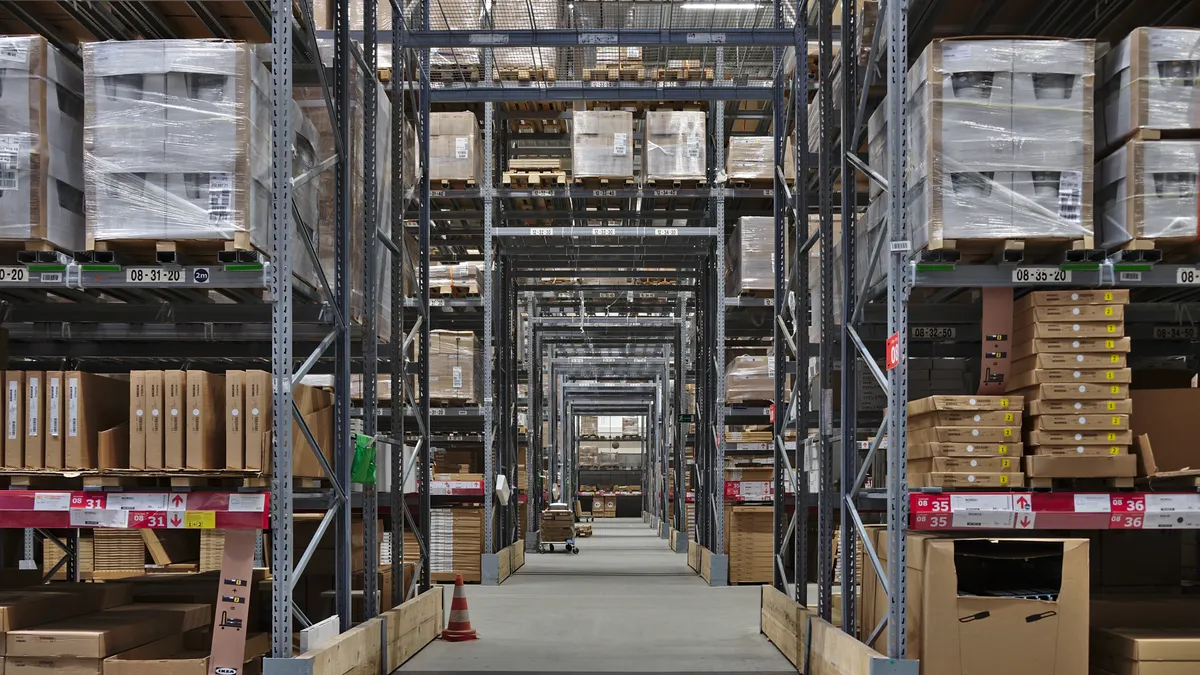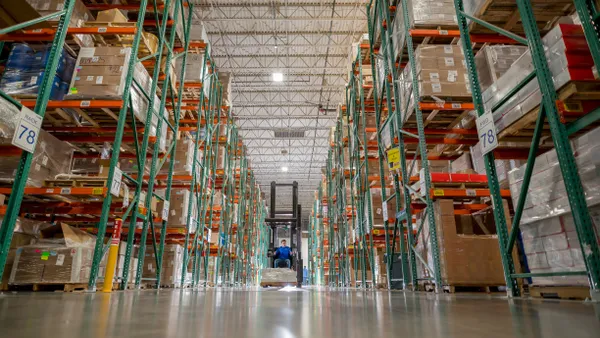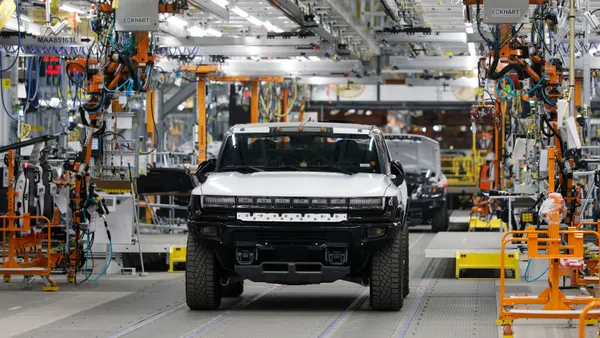Dive Brief:
- Nonfarm inventories value fell nearly $10 billion in the first quarter of 2020 compared to the fourth quarter of 2019, according to early estimates from the Bureau of Economic Analysis (BEA) released last week.
- The drop is the first sign of contracting inventories since the second quarter of 2018, according to numbers from BEA.
- February inventory data from the Census Bureau, the most recent available, show a year-over-year (YoY) increase in inventory for manufacturers but declines for retailers and wholesalers. Meanwhile, manufacturers experienced a YoY decrease in sales but retailers and wholesalers saw increased sales.

Dive Insight:
Inventories can fall as a result of increased and decreased demand, according to National Retail Federation Chief Economist Jack Kleinhenz. And the first quarter brought holiday-level demand at grocery stores, but also falling demand just about everywhere else outside of healthcare, as the nation responded to the coronavirus pandemic. In some cases, inventories were not produced because of factory shutdowns across the country.
"So, what's happened here in this quarter is less inventory; less products were produced," Kleinhenz said in an interview with Supply Chain Dive. "But on the other hand, the story is probably: inventories were drawn down in certain areas, consumed more than produced, and that probably intensified the negative number."
The numbers from the Census Bureau highlight that not all industries have experienced the same change in inventories, with retail and manufacturing moving in opposite directions in February. The difference could partially be the result of unfinished products and components building up in factories, according to Simon Ellis, the program VP for supply chain strategy at IDC.
If manufacturers are unable to get all the components they need to finish a product, then "you're going to end up with large inventories at those intermediate manufacturing points. But you're not going to have a lot of inventory in retail, because you can't get to the finished good," Ellis said in an interview. Other manufacturers many have engaged in some forward buying in anticipation of shortages, he said.
The inventory number takes into account finished goods inventory, work-in-progress inventory, materials and in-bound inventory. The impact the pandemic is having on inventory levels will vary depending on the industry, according to GEP VP Mudit Kumar.
Industries such as packaged food, consumer care brands and paper products are "doing pretty well" and experiencing steady demand, Kumar said. "What we are seeing then is that their finished goods inventory is depleting, they're keeping up with the demand somehow, and they're starting to build up inventory on the supply side to be able to keep up with that demand and with the uncertainties that are coming up with COVID-19."
But industries without steady demand will see an increase in their finished goods inventory. This includes the automotive sector and items like appliances, Kumar's colleague David Doran said in the same interview.
The inventory numbers highlight how an event like the pandemic exposes the fragility of just-in-time supply chains for many industries, said Doran, a VP at GEP. One reason for falling inventories has been the inability to access goods and components from international suppliers, he said.
"I suspect, as we get out of this, we're going to see a little bit larger inventories," he said. "Cash is still king, but we still have that buffer."
Companies will need to move beyond looking at the supply chain as an area in which costs can be cut and processes optimized, and instead think of ways to increase resiliency, Kumar said.
The historical context is also important here, according to Institute for Supply Management CEO Tom Derry. Many companies built up inventories in 2019 in an attempt to avoid tariffs on Chinese goods, he said.
"You've seen the expected depletion of inventories after that build-up," Derry said. Companies drew down inventories throughout the first quarter with normal production cycles and haven't been able to replenish orders from China, he said. (Imports that go into a company's inventory and are not for final consumption are listed in the inventory line, not the import line, in the BEA's numbers, the agency told Supply Chain Dive.)
"[T]here’s not enough replenishment occurring due to transportation and labor disruptions," Resilinc CEO Bindiya Vakil said in an email to Supply Chain Dive. "There are simply not enough materials coming in. There are signs shipping is starting to return in different lanes, but it’s not 100%."
So far, the inventory numbers from the first quarter reflect higher demand in some product categories and issues around supply, which highlight issues along the supply chain. The next wave of inventory reductions will likely come as demand falls and companies look to cut costs, Ellis said.
For the remainder of the year, companies will be careful about how much inventory they build, "because they don't really know what the demand is going to be for their products," he said.
The demand forecasting algorithms that companies use rely on historical data to predict future behavior. But right now there isn't a lot of information in that historical data to help guide companies. So, figuring out the right level of inventory could be hard, Ellis said.
"It's a horrible dilemma," he said.
This is an issue Chinese manufacturers have already faced. Factories in China reopened, but a lack of demand for certain products led to workers getting furloughed in some locations, Ellis said.
"If consumers don't come back, we got a big problem with the economy in this country," he said. "So, I worry much more about the demand, frankly, than I do supply."
This story was first published in our weekly newsletter, Supply Chain Dive: Operations. Sign up here.














